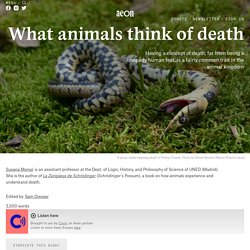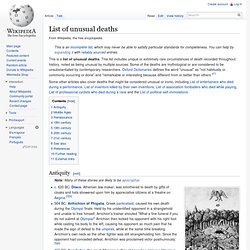

Encyclopedia of Death and Dying. Alan Watts on Death, in a Beautiful Animated Short Film. By Maria Popova “Think about that for a while — it’s kind of a weird feeling when you really think about it…” Philosopher and writer Alan Watts (1915-1973) is best-known for authoring the cult-classic The Way of Zen and popularizing Eastern philosophy in the West alongside John Cage.

In this hauntingly beautiful animation based on a Watts lecture, produced by Luke Jurevicius and directed by Ari Gibson and Jason Pamment, Watts considers what death might be, exploring the notion of nonexistence and pitting it as “the necessary consequence of what we call being.” UPDATE: A reader points out that the animation comes from a video for “Sometimes the Stars” by Australian band The Audreys from their 2010 debut album of the same title. What you see here is a mashup of the video and an Alan Watts recording. What’s it gonna be like, dying? Complement with Watts’s poignant probing of what you would do if money were no object.
Donating = Loving Brain Pickings has a free weekly newsletter. Cimetières. On Death and Dying. Death. Who's Alive and Who's Dead. Sobre la muerte. Morbid. Towers of Silence: Zoroastrian Architectures for the Ritual of Death. Simon Critchley on the History of Death (transcript) Transcript Question: How do contemporary societies conceive of death?

Critchley: Every culture has had rituals around death, all right. It’s a constant feature of what it means to be human. It’s human culture and what makes our culture unique is our inability to really face up to it, to death, and touch it, have appropriate rituals that surround it. What interest me about, I mean, the book is about the philosophical ideal of death or, and that is something that you find emerges in the end of the, with the death of Socrates, the end of the 4th century B.C. and the idea there is that to philosophize is to learn how to die and the philosopher is the person who can die the good death and dying the good death is essential to the wisdom that constitutes what it might mean to live.
Animals wrestle with the concept of death and mortality. When the Virginia opossum feels threatened, she plays dead.

Lying on the ground, curled up into something resembling the foetal position, with her eyes and mouth open and her tongue hanging out, she stops responding to the world. Her body temperature drops. Her breathing and heart rate are severely reduced. Her tongue, usually pink, takes on a blueish hue. She urinates, defecates, and expels a putrid-smelling liquid from her anal glands. Despite the persuasive performance of death, no one would assume that the opossum herself believes that she’s playing dead. Humans have long thought of themselves as the only animal with a notion of mortality. Biocentrism Explains Why There’s No Time and No Death.
Okay, I admit it.

They had me at “You won’t actually die.” I want to believe. Dr. What to do when an astronaut dies in space. Courtesy of Warner Bros.

Pictures This article is part of Future Tense, a collaboration among Arizona State University, New America, and Slate. Future Tense explores the ways emerging technologies affect society, policy, and culture. On Thursday, April 9, Future Tense will host an event in Washington, D.C., on the future of space exploration. For more information and to RSVP, visit the New America website. It’s raining in Washington on July 24, 1969. So goes the speech commemorating the deaths of Neil Armstrong and Buzz Aldrin following the first moon landing. List of unusual deaths. This is a list of unusual deaths.

This list includes unique or extremely rare circumstances of death recorded throughout history, noted as being unusual by multiple sources. Some of the deaths are mythological or are considered to be unsubstantiated by contemporary researchers. Oxford Dictionaries defines the word "unusual" as "not habitually or commonly occurring or done" and "remarkable or interesting because different from or better than others. Terror Management Theory (TMT) Lavieapreslavie. Thannisan.
EMI NDE. Out of Body Experience. Near Death Experience. Stati Post-Mortem nell’Islam e nel Buddismo tibetano. Il Barzakh – Le tre Leonesse. Gli insegnamenti meditativi a cui fanno riferimento gli scritti del Bardo thödröl riguardano due categorie di tecniche: il processo di compimento (tibet. zokrìm), e il processo di creazione (tibet. kyerìm).

Il secondo processo meditativo, diversamente dal primo, è caratterizzato dallo sviluppo dell’immaginazione creativa[9] sostenuta dalla devozione[10]. Fondamentalmente consiste nel visualizzare all’esterno di sé il sambhogakāya o il dharmakāya come una figura divina (solitamente un Buddha, un Bodhisattva a volte uniti alle loro paredre tantriche[11]) – in tibetano yidàm lha (sans. iṣṭadevatā) – e immaginare di fondersi con essa, riconoscendo l’essenziale vacuità di quella forma. Affinché questo processo avvenga non deve verificarsi l’interrogatorio degli angeli[12], Munkar e Nakir (A), che sono così allontanati dalla catena iniziatica dei maestri (arab. Silsila; sans. Parampara), in quanto essa risponde per quel singolo essere, in forza della sua connessione al Principio Supremo.